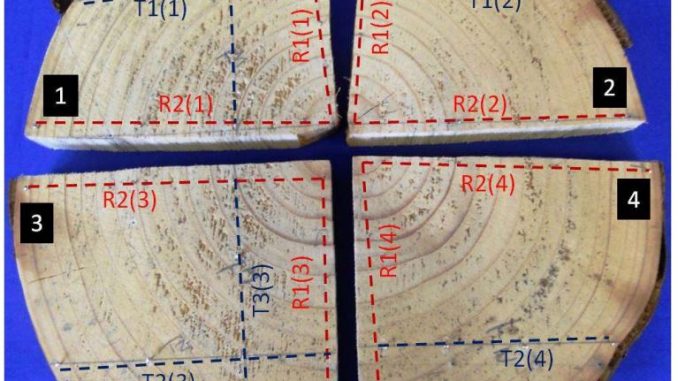
Congratulations to Jas Canavan on graduating with a PhD. His thesis (” The effects of drying on the dimensional stability of spruce wood”) is available to download from Glasgow University’s repository. http://theses.gla.ac.uk/8134/
Jas was working with SIRT research partner Mike Jarvis – and helped us out on a number of our research projects too.
Abstract:
“Sitka spruce (Picea sitchensis (Bong.) Carr.) has been the most common forestry species in UK plantations for many decades. It is generally fast grown in short rotation, which has implications for quality. The harvested timber has a number of end-use applications. Of these, sawn construction grade timber is at the high end of market value. Currently, under one third of home grown sawn timber processed by sawmills achieves the required C16 or higher grading for construction class timber. Presently there is significant standing stock of 40 years old or under. Improvements in timber quality would create significant benefits for growers and processors. Distortion in kiln dried sawn timber is a considerable barrier to improving grading classification and marketability. Twist in particular accounts for around six percent of the rejections after kiln drying. Additional twist when timber dries further; in storage, at construction sites or in-service, is perceived as a marketing issue. The focus of this work was to better understand the evolution of twist during the drying process and seek to improve quality by examining the key properties in sawn timber that contribute to the formation of twist. Samples of regularly processed full size (3 m in length) sawn timber were kiln dried with no restraint to promote maximum twist. This was done in three stages to assess the impact of intermittent drying. Measurements of twist, moisture content, acoustic velocity and basic dimensions were taken before and after each drying cycle. The results showed highly significant differences between battens containing the pith and those that did not. Drying in stages did not seem to affect the linearity of the moisture content against twist relationship. Twist was seen to develop at a consistent rate throughout the process regardless of the final amount of twist accrued or the position from which the batten was sawn. Where timber is likely to dry to lower moisture content after sale it is therefore possible to predict the additional twist from the moisture content expected and allow for it by stricter grading than the twist standard demands. Twist was seen to decrease slightly during a lengthy period of storage in controlled conditions between drying cycles. This may allude to a relaxation effect which could have implications for timber distortion in-service but this would require a more extensive study before any such conclusions could be drawn. A second batch of unrelated samples, were kiln dried to 12% MC under restraint. All of these samples contained the pith along their length and all developed significant amounts of twist. This suggests that battens containing the pith will twist regardless of restraint. A method was developed to measure longitudinal shrinkage. This required the batten size to be reduced to fit the method and battens were sawn into 3 x 1 m sections. Battens were re-saturated and measured daily throughout air drying until an equilibrium moisture content was achieved. Measurements of transverse shrinkage were also taken concurrently. No relationship could be found between the longitudinal and transverse results. When plotted against the data for twist a positive relationship was found with longitudinal shrinkage. Acoustic tools were used to calculate dynamic stiffness. As the values for acoustic velocity squared correlated well with dynamic stiffness, other possible relationships were explored. Good agreement was found with twist and longitudinal shrinkage. This suggests it may be possible to predict twist in sawn timber directly or as a function of microfibril angle, using acoustic tools. A simple method for measuring grain angle was devised. Discs taken from the trees used in the drying experiment were measured for grain angle to compare with other measured properties. The measurement method worked well but the sample size was small and the discs too thin to provide good quality data quality. The results were not as instructive as expected. A vague relationship with twist was found. A repeat of the experiment with an improved method could yield more conclusive results. A method was developed to measure radial and tangential shrinkage in discs. Discs of Sitka spruce from a different source were used. Discs were saturated and allowed to dry with the expectation of cracks developing. The intention was to explore the nature of internal stresses present in intact discs and why tangential and radial shrinkage differs. As only one disc cracked the scope of comparison was limited but it was apparent that the greater shrinkage tendency in the tangential direction was responsible for radial cracking.”

Leave a Reply
You must be logged in to post a comment.